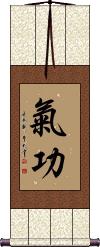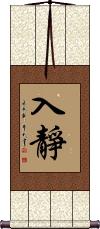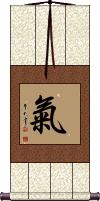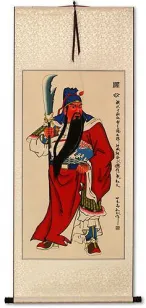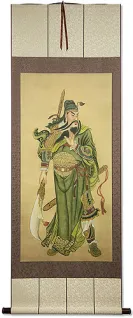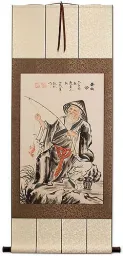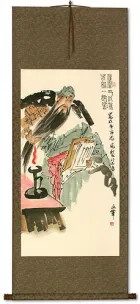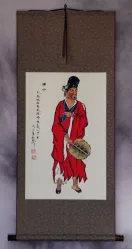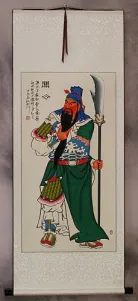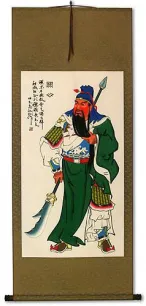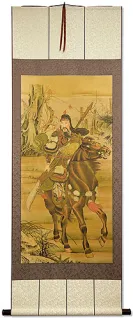Many custom options...
And formats...

Qi Gong in Chinese / Japanese...
Buy a Qi Gong calligraphy wall scroll here!
Personalize your custom “Qi Gong” project by clicking the button next to your favorite “Qi Gong” title below...
Qi Gong / Chi Kung
氣功 or Qigong is the title of a technique that is somewhere between medical practice, meditation, and in some cases, religion.
The definition is blurred depending on which school of Qigong you are following. In some cases, it is even incorporated with martial arts.
Some people (even Chinese people) mix this title with Tai Chi (Tai Qi) exercises.
Lately, in China, people will claim to practice Tai Chi rather than Qigong because the Qigong title was recently used as a cover for an illegal pseudo-religious movement in China with the initials F.G. or F.D. (I can not write those names here for fear of our website being banned in China).
You can learn those names and more here: Further info about Qigong
If you are wondering why I wrote “Qi Gong” and “Chi Kung” as the title of this calligraphy entry, I should teach you a little about the various ways in which Chinese can be Romanized. One form writes this as “Chi Kung” or “Chikung” (Taiwan). In the mainland and elsewhere, it is Romanized as “Qi Gong” or “Qigong.” The pronunciation is the same in Taiwan, mainland, and Singapore Mandarin. Neither Romanization is exactly like English. If you want to know how to say this with English rules, it would be something like “Chee Gong” (but the “gong” has a vowel sound like the “O” in “go”).
Romanization is a really confusing topic and has caused many Chinese words to be mispronounced in the west. One example is “Kung Pao Chicken,” which should actually be more like “Gong Bao” with the “O” sounding like “oh” for both characters. Neither the Romanization system in Taiwan nor the Mainland is perfect, in my opinion, and leads to many misunderstandings.
In modern Japan, you may see this written as 気功, but the original 氣功 is still recognized. If you need the Japanese version, please contact me.
Three Treasures of Chinese Medicine
精, 氣, 神 are the characters jing, qi, and shen.
As a set, these three characters are known in English as the treasures of traditional Chinese medicine, the treasures of Qi Gong, or the three treasures of Taoism / Daoism.
Sometimes this set is titled 三寶 (sānbǎo) or “three treasures,” but here, we're writing each treasure out.
Here's how these characters are perceived in this context...
Jing: nutritive essence; refined; perfected; pure
Qi: vitality; energy; force; breath; vigor
Shen: spirit; soul; mind; being
To keep it simple, you can use “essence, vitality, and spirit” to define these.
Sit Quietly in Meditation
A state of mind
入靜 is used in Taoism and Qi Gong to describe the state you can reach while sitting quietly in meditation. It contains the idea of achieving a highly-tranquil and peaceful state. Some may describe this state as “sleeping while still awake.”
If you have a relaxation or meditation room, this is the calming wall scroll that you would want hanging in that room.
Life Energy / Spiritual Energy
Chi Energy: Essence of Life / Energy Flow
This 氣 energy flow is a fundamental concept of traditional Asian culture.
氣 is romanized as “Qi” or “Chi” in Chinese, “Gi” in Korean, and “Ki” in Japanese.
Chi is believed to be part of everything that exists, as in “life force” or “spiritual energy.” It is most often translated as “energy flow” or literally as “air” or “breath.” Some people will simply translate this as “spirit,” but you must consider the kind of spirit we're talking about. I think this is weighted more toward energy than spirit.
The character itself is a representation of steam (or breath) rising from rice. To clarify, the character for rice looks like this: ![]()
Steam was apparently seen as visual evidence of the release of “life energy” when this concept was first developed. The Qi / Chi / Ki character is still used in compound words to mean steam or vapor.
The etymology of this character is a bit complicated. It's suggested that the first form of this character from bronze script (about 2500 years ago) looked like these samples: 

However, it was easy to confuse this with the character for the number three. So the rice radical was added by 221 B.C. (the exact time of this change is debated). This first version with the rice radical looks like this: 
The idea of Qi / Chi / Ki is really a philosophical concept. It's often used to refer to the “flow” of metaphysical energy that sustains living beings. Yet there is much debate that has continued for thousands of years as to whether Qi / Chi / Ki is pure energy or consists partially or fully of matter.
You can also see the character for Qi / Chi / Ki in common compound words such as Tai Chi / Tai Qi, Aikido, Reiki, and Qi Gong / Chi Kung.
In the modern Japanese Kanji, the rice radical has been changed into two strokes that form an X.
![]() The original and traditional Chinese form is still understood in Japanese, but we can also offer that modern Kanji form in our custom calligraphy. If you want this Japanese Kanji, please click on the character to the right instead of the “Select and Customize” button above.
The original and traditional Chinese form is still understood in Japanese, but we can also offer that modern Kanji form in our custom calligraphy. If you want this Japanese Kanji, please click on the character to the right instead of the “Select and Customize” button above.
More language notes: This is pronounced like “chee” in Mandarin Chinese, and like “key” in Japanese.
This is also the same way to write this in Korean Hanja where it is Romanized as “gi” and pronounced like “gee” but with a real G-sound, not a J-sound.
Though Vietnamese no longer use Chinese characters in their daily language, this character is still widely known in Vietnam.
See Also: Energy | Life Force | Vitality | Life | Birth | Soul
Tai Chi Ball
This in-stock artwork might be what you are looking for, and ships right away...
Gallery Price: $200.00
Your Price: $79.88
Guan Gong Warrior Saint
Large Wall Scroll
Discounted Blemished
Gallery Price: $71.00
Your Price: $39.00
Gallery Price: $200.00
Your Price: $79.88
Gallery Price: $200.00
Your Price: $79.88
Gallery Price: $200.00
Your Price: $79.88
Gallery Price: $200.00
Your Price: $79.88
Not the results for qi gong that you were looking for?
Below are some entries from our dictionary that may match your qi gong search...
| Characters If shown, 2nd row is Simp. Chinese |
Pronunciation Romanization |
Simple Dictionary Definition |
鉦 钲 see styles |
zhēng zheng1 cheng kane; shou / kane; sho かね; しょう |
gong used to halt troops gong; handbell; (given name) Masashi A small gong struck during the worship, or service. |
銅鑼 铜锣 see styles |
tóng luó tong2 luo2 t`ung lo tung lo dōra どら |
gong (kana only) gong; tam-tam A gong. |
愚公 see styles |
gukou / guko ぐこう |
(char) Yu Gong (main character in the 4th century BC Chinese fable "The Foolish Old Man Removes the Mountains"); Yúgōng; Yukong; (ch) Yu Gong (main character in the 4th century BC Chinese fable "The Foolish Old Man Removes the Mountains"); Yúgōng; Yukong |
飯磬 饭磬 see styles |
fàn qìng fan4 qing4 fan ch`ing fan ching |
The dinner-gong. |
コンク see styles |
gongu ゴング |
(1) (See 銅鑼・どら) gong (instrument); (2) {sports} gong (sound at the end of round, etc.); (personal name) Kongu |
李洪志 see styles |
lǐ hóng zhì li3 hong2 zhi4 li hung chih rikoushi / rikoshi りこうし |
Li Hongzhi (1951-), founder of Falun Gong 法輪功|法轮功[Fa3 lun2 gong1] (person) Li Hongzhi (1951-) (founder of the Falun Gong) |
法輪功 法轮功 see styles |
fǎ lún gōng fa3 lun2 gong1 fa lun kung hourinkou; farungon / horinko; farungon ほうりんこう; ファルンゴン |
Falun Gong (Chinese spiritual movement founded in 1992, regarded as a cult by the PRC government) Falun Gong; Falun Dafa |
無常磬 无常磬 see styles |
wú cháng qìng wu2 chang2 qing4 wu ch`ang ch`ing wu chang ching mujō kei |
無常鐘 The passing bell, or gong, for the dying. |
こんちゃ see styles |
goncha ゴンチャ |
(company) Gong Cha (Taiwan); (c) Gong Cha (Taiwan) |
開臺鑼鼓 开台锣鼓 see styles |
kāi tái luó gǔ kai1 tai2 luo2 gu3 k`ai t`ai lo ku kai tai lo ku |
opening gong; gong strokes announcing start of opera performance |
當面鑼,對面鼓 当面锣,对面鼓 see styles |
dāng miàn luó , duì miàn gǔ dang1 mian4 luo2 , dui4 mian4 gu3 tang mien lo , tui mien ku |
lit. gong facing gong, drum opposite drum (idiom); fig. to come together to thrash out the issue face to face |
磬 see styles |
qìng qing4 ch`ing ching kei / ke けい |
More info & calligraphy: Khánhsounding stone; qing; ancient Chinese chime shaped like a chevron (inverted 'v'), orig. of stone, today often metal, in Japan primarily used at Buddhist temples; (given name) Kei A piece of flat stone or metal, used as a gong, or for musical percussion. |
龔 龚 see styles |
gōng gong1 kung kū |
More info & calligraphy: Kung / Gongto provide |
こん see styles |
gon ごん |
(archaism) (feminine speech) (secret language of court ladies) (See 牛蒡) great burdock; (place-name) Gong; Khong; Conn |
コーン see styles |
goon ゴーン |
More info & calligraphy: Coan |
呯 see styles |
píng ping2 p`ing ping |
(onom.) bang! (gong, gun firing etc) |
敲 see styles |
qiāo qiao1 ch`iao chiao noboru のぼる |
to hit; to strike; to tap; to rap; to knock; to rip sb off; to overcharge (given name) Noboru To knock, beat, pound, e.g. a drum, gong, or gate. |
椎 see styles |
zhuī zhui1 chui shii; shii / shi; shi しい; シイ |
(bound form) vertebra (kana only) any beech tree of genus Castanopsis; chinquapin; chinkapin; (female given name) Shiina A hammer, especially for a gong, etc.; idem 槌. |
篩 筛 see styles |
shāi shai1 shai furui ふるい |
(bound form) a sieve; to sieve; to sift; to filter; to eliminate through selection; to warm a pot of rice wine (over a fire or in hot water); to pour (wine or tea); (dialect) to strike (a gong) (1) sieve; sifter; screen; (2) screening (jobs, candidates, etc.) |
錚 铮 see styles |
zhēng zheng1 cheng |
clang of metals; small gong |
鑼 锣 see styles |
luó luo2 lo |
gong; CL:面[mian4] |
ちん see styles |
chin チン |
jing (Korean gong) (kor:); (place-name) Chin (Burmah); Ching; Chinn; Zinn |
喚鐘 唤钟 see styles |
huàn zhōng huan4 zhong1 huan chung kanshō |
半鐘 (or飯鐘) The dinner bell or gong. |
子貢 子贡 see styles |
zǐ gòng zi3 gong4 tzu kung shikou / shiko しこう |
Zi Gong or Duanmu Ci 端木賜|端木赐[Duan1 mu4 Ci4] (520 BC-), disciple of Confucius (personal name) Shikou |
廝鑼 厮锣 see styles |
sī luó si1 luo2 ssu lo |
small gong |
敲鑼 敲锣 see styles |
qiāo luó qiao1 luo2 ch`iao lo chiao lo |
to beat a gong |
曾鞏 曾巩 see styles |
zēng gǒng zeng1 gong3 tseng kung soukyou / sokyo そうきょう |
Zeng Gong (1019-1083), Song dynasty writer, one of the eight giants 唐宋八大家[Tang2-Song4 ba1da4jia1] (personal name) Soukyō |
木鐸 木铎 see styles |
mù duó mu4 duo2 mu to bokutaku ぼくたく |
(1) bell with wooden clapper; (2) leader; guide (of the public) wooden gong |
木魚 木鱼 see styles |
mù yú mu4 yu2 mu yü mokugyo もくぎょ |
mokugyo; wooden fish (percussion instrument) (Buddhist term) fish gong; fish wood block; temple block; round, hollow, wood block (vaguely fish-shaped, usu. with scales), struck while chanting sutras The wooden fish; there are two kinds, one round for use to keep time in chanting, the other long for calling to meals. The origin of the use of a fish is unkজxample to monks to be watchful: there is no evidence of connection with the Christian ίχθύς.ί 木馬 Wooden horse, a symbol of emancipation. |
杢魚 see styles |
mokugyo もくぎょ |
(Buddhist term) fish gong; fish wood block; temple block; round, hollow, wood block (vaguely fish-shaped, usu. with scales), struck while chanting sutras |
Click here for more qi gong results from our dictionary
The following table may be helpful for those studying Chinese or Japanese...
| Title | Characters | Romaji (Romanized Japanese) | Various forms of Romanized Chinese | |
| Qi Gong Chi Kung | 氣功 气功 | ki kou / kikou / ki ko | qì gōng / qi4 gong1 / qi gong / qigong | ch`i kung / chikung / chi kung |
| Three Treasures of Chinese Medicine | 精氣神 精气神 | jīng qì shén jing1 qi4 shen2 jing qi shen jingqishen | ching ch`i shen chingchishen ching chi shen |
|
| Sit Quietly in Meditation | 入靜 入静 | rù jìng / ru4 jing4 / ru jing / rujing | ju ching / juching | |
| Life Energy Spiritual Energy | 氣 气 / 気 | ki | qì / qi4 / qi | ch`i / chi |
| Tai Chi Ball | 太極球 太极球 | tai kyoku kyuu taikyokukyuu tai kyoku kyu | tài jí qiú tai4 ji2 qiu2 tai ji qiu taijiqiu | t`ai chi ch`iu taichichiu tai chi chiu |
| In some entries above you will see that characters have different versions above and below a line. In these cases, the characters above the line are Traditional Chinese, while the ones below are Simplified Chinese. | ||||
Successful Chinese Character and Japanese Kanji calligraphy searches within the last few hours...
